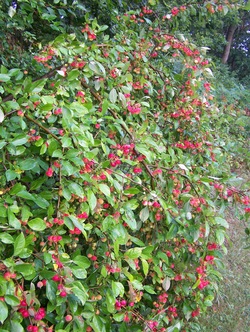 Crabapples Crabapples When I worked in Manhattan, I made a habit of buying a "new" apple at the Union Square farmer's market each week. Though I'd grown up in apple growing country, I could recognize only a dozen or so varieties (Red and Golden Delicious are SO not. HoneyCrisp -- is.). It was cheap education, the market: fifty cents or so for lunch with a history lesson for free. Apples are in the same family as roses. The New World had crabapples (ironically enough), but apples and bees came over with the Europeans, or so the sources say. The Europeans got them from China, of course, around 8000 BC. According to what archeologists have unearthed recently at the circa 6500 BC battle site in Jordan, apples were among the things Joshua fit at the battle of Jericho (Jericho o-ho). There are more than 7500 varieties of apples in the world. 2500+ just in North America. Yellow, pink, green, red, purple fruits with flesh that might be white, green, yellow, pink, streaked or checked. Pie apples, eating apples, apples for cider, apples that store well or dry well or make delicious sauce. In the literature, they are rated by crispness, grain, thinness of skin, tendency to bruise, acidity, sweetness, color of skin and flesh, spice, size of tree and fruit, resistance to disease, storage capacity, etc., etc.  I love that the formal description might include the phrase: "good for eating out of hand." Here're the names of a few varieties I like:
 Apple-trees can long outlive the farmer and the farm. It's one of the "tells" of a lost farm: asparagus crowns in the early spring, lilac bushes blooming in the late spring, and apples on the tree in late summer and fall. Even after the stone-laid foundations have collapsed and been absorbed back into the land, apple-trees continue to bloom and produce. Even when a forest grows up around the grove, the trees keep going, stretching up through the canopy for sunlight. Even after decades and lightning strikes and ice-storms, they keep sending up young buds and branches. Which seems like some kind of miraculous.
0 Comments
Leave a Reply. |
About the Blog
A lot of ground gets covered on this blog -- from sailboat racing to book suggestions to plain old piffle. FollowTrying to keep track? Follow me on Facebook or Twitter or if you use an aggregator, click the RSS option below.
Old school? Sign up for the newsletter and I'll shoot you a short e-mail when there's something new.
Archives
June 2024
Categories
All
|
 RSS Feed
RSS Feed
